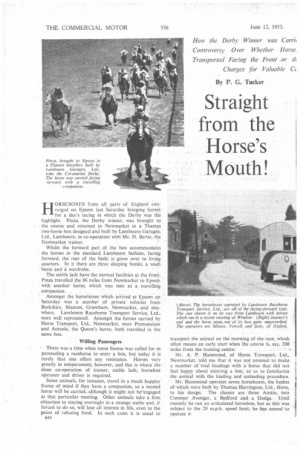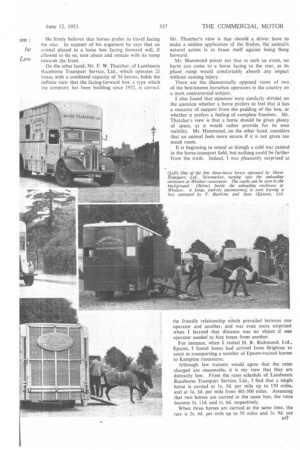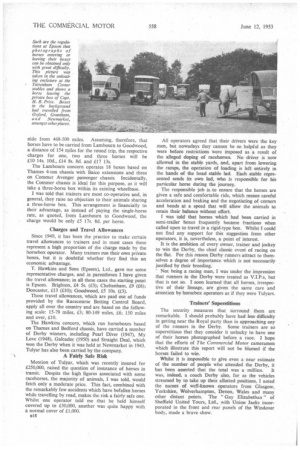Straight from the Horse's Mouth!
Page 50

Page 51

Page 52

If you've noticed an error in this article please click here to report it so we can fix it.
By P. G. Tucker How the Derby Winner was Carril Controversy Over Whether Horse. Transported Facing the Front or Charges for Valuable Cc
HORSEBOXES from all parts of England converged on Epsom last Saturday bringing horses for a day's racing in which the Derby was the highlight. Pinza, the Derby winner, was brought to the course and returned to Newmarket in a Thames two-horse box designed and built by Lambourn Garages,
Ltd., Lambourn, in co-operation with Mr. N. Bertie, the Newmarket trainer.
Whilst the forward part of the box accommodates the horses in the standard Lambourn fashion, facing forward, the rear of the body is given over to living quarters. In it there are three sleeping bunks, a wash basin and a wardrobe.
The stable lads have the normal facilities at the front. Pinza travelled the 86 miles from Newmarket to Epsorn with another horse, which was sent as a travelling companion. .
Amongst the horseboxes which_ arrived at Epsom on ' Saturday was a number of private vehicles from Berkshire, Manton, Grantham, Newmarket, and elsewhere. Lambourn Racehorse Transport Service, Ltd., were well represented. Amongst the horses carried by Horse Transport, Ltd., Newmarket, were Premonition and Aureole, the Queen's horse; both travelled in the same box.
Willing Passengers There was a time when some finesse was called for in persuading a racehorse to enter a box, but today it is rarely that One offers any resistance. Horses vary greatly in temperament, however, and this is where the close co-operation of trainer, stable lads, horsebox operator and driver is required.
Some animals, for instance, travel in a much happier frame of mind if they have a companion, so a second horse will be carried, although it might not beengaged at that particular meeting. Other animals take a firm objection to staying overnight in a strange stable and. if forced to do so, will lose all interest in life, even'to the point of refusing food. In such cases it is usual to B16
transport the animal on the morning of the race, which often means an early start when the course is, say, 200
miles from the training centre. V.
Mr. A. P. " Hammond, of Horse Transport, Ltd., Newmarket, told me that it was not unusual to make a number of trial loadings with :ahorse that did not feel happy about entering a box, soas to familiarize the animal with the loading and unloading procedure.
Mr. Hamniond operates seven horseboxes, the bodies of which were built by Thomas Harrington, Ltd., Hove, to his design. The chassis are three Austin, two Commer Avenger, a Bedford and a Dodge. Until recently he ran an articulated horsebox, but as this was subject to the 20 m.p.h. speed limit, he--has ceased to operate it
He firmly believes that horses prefer to travel facing the rear. in support of his argument he says that an animal placed in a loose box facing forward will, if allowed to do so, turn about and remain with its rump towards the front.
On the other hand, Mr. F. W. Thatcher, of Lambourn Racehorse Transport Service, Ltd., which operates 21 boxes with a combined capacity of 54 horses, holds the definite view that the facing-forward box, a type which the company has been building since 1932, is correct. Mr.Thatcher's view is that should a driver have to make a sadden application of the brakes, the animal's natural action is to brace itself against being flung forward.
Mr. Hammond points out that in such an event, no harm can come to a horse facing. to the rear, as its pliant rump would comfortably absorb any impact .without causing injury.
There are the diametrically opposed Views of two of the best-known horsebox operators in the country on a most controversial subject.
I also found that opinions were similarly divided on the question whether a horse prefers to feel that it has a measure of support from the padding of the box, or whether it prefers a feeling of complete freedom. Mr. Thatcher's view is that a horse should be given plenty of space, as it would rather provide for its own stability. Mr. Hammond, on the other hand, considers that an animal feels more secure if it is not given too
much room. • It is beginning to sound as though a cold war existed in the horse-transport field, but nothing could be farther from the truth. Indeed, I was pleasantly surprised at
the friendly relationship which prevailed between one operator and another, and was even more surprised when I learned that distance was no object if one operator needed to hire boxes from another.
For instance, when I visited H. R. Richmond, Ltd., Epsom, I found boxes had arrived from Brighton to assist in transporting a number of Epsom-trained horses to Kempton racecourse.
Although few trainers would agree that the rates charged are reasonable, it is my view that they are distinctly low. From the rates schedule of Lamboum Racehorse Transport Service, Ltd., I find that a single horse is carried at is. 5d. per mile up to 150 miles, and at Is. 3d. per mile from 401-500 miles. Assuming that two horses are carried in the same box, the rates become Is. lid, and Is. 6d. respectively.
When three horses are carried at the same time, the rate is 2s. 6d. per mile up to 50 miles and ls. 9d. per B11 mile from 468-500 miles. Assuming, therefore, that horses have to be carried from Lamboum to Goodwood, a distance of 154 miles for the round trip, the respective charges for one, two and three horses will be £10 14s. 10d., £14 8s. 8d. and £17 13s.
The Lambourn concern operates 18 boxes based on Thames 4-ton chassis with Baico extensions and three on Commer Avenger passenger chassis. Incidentally, the Commer chassis is ideal for this purpose, as it will take a three-horse box within its existing wheelbase.
I was told that trainers are most co-operative and, in general, they raise no objection to their animals sharing a three-horse box. This ,arrangement is financially to their advantage, as instead of paying the single-horse rate, as quoted, from Lamboum to Goodwood, the charge would be only £5 17s. 8d. per horse.
Charges and Travel Allowances Since 1949, it has been the practice to make certain travel allowances to trainers and in most cases these represent a high proportion of the charge made by the horsebox operator. Many trainers run their own private boxes, but it is doubtful whether they find this an economic advantage.
T. Hawkins and Sons (Epsom), Ltd., gave me some representative charges, and in parentheses I have given the travel allowance; in all these cases the starting point is Epsom. Brighton, £4 5s. (£3); Cheltenham, £9 (£6); Doncaster, £13 (£10); Goodwood, £5 10s. (£3).
These travel allowances, which are paid out of funds provided by the Racecourse Betting Control Board, apply all over the country and are based on the following scale: 15-79 miles, £3; 80-149 miles, £6; 150 miles and over, £10.
The Hawkins concern, which run horseboxes based on Thames and Bedford chassis, have carried a number of Derby winners, including Pearl Diver (1947), My Love (1948), Galcador (1950) and Straight Deal, which won the Derby when it was held at Newmarket in 1943. Tulyar has also been carried by the company.
A Fairly Safe Risk Mention of Tulyar, which was recently insured for £250,000, raised the question of insurance of horses in transit. Despite the high figures associated with some racehorses, the majority of animals, I was told, would fetch only a moderate price. This fact, combined with the remarkably few accidents which have befallen horses while travelling by road, makes the risk a fairly safe one. Whilst one operator told me that he held himself covered up to £30,000, another was quite happy with a normal cover of £1,000.
at8 All operators agreed that their drivers were the key men, but nowadays they cannot be so helpful as they were before restrictions were imposed as a result of the alleged doping of racehorses. No driver is now allowed in the stable yards, and, apart from lowering the ramps, the operation of loading is left entirely in the hands of the head stable lad. Each stable represented sends its own lad, who is responsible for his particular horse during the journey.
The responsible job is:to ensure that the horses are given a safe and comfortable ride, which means careful acceleration and braking and the negotiating of corners and bends at a speed that will allow the animals to retain their balance without effort.
I was told that horses which had been carried in semi-trailer boxes frequently became fractious when called upon to travel in a rigid-type box. Whilst I could not find any support for this suggestion from other operators, it is, nevertheless, a point of interest.
It is the ambition of every owner, trainer and jockey to win the Derby, the chief classic event of racing on the flat. For this reason Derby runners attract to themselves a degree of importance which is not necessarily justified by their breeding.
• Not being a racing man, I was under the impression that runners in the Derby were treated as V.I.P.s, but that is not so. I soon learned that all horses, irrespective of their lineage, are given the same care and attention by horsebox operators as if they were Tulyars.
Trainers' Superstitions The security measures that surround them arc remarkable. I should probably have had less difficulty in getting near the Royal party than in approaching any of the runners in the Derby. Some trainers are so superstitious that they consider it unlucky to have one of their horses photographed before a race. I hope that the efforts of The Commercial Motor cameramen which illustrate this report will not be blamed if the horses failed to win.
Whilst it is impossible to give even a near estimate of the number of people who attended the Derby, it has been asserted that the total was a million. It was, indeed, a coach Derby also, for as the vehicles streamed by to take up their allotted positions, I noted the names of well-know-n operators from Glasgow, Yorkshire, Wolverhampton, Devon, Wales and many other distant points. The "Gay Elizabethan" of Sheffield United Tours, Ltd., with Union Jacks incorporated in the front and rear panels of the Windover body, made a brave show.




































































































